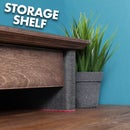Introduction: DIY Laptop Table - Using Limited Tools & Plywood
I have been needing a laptop table for a long time now so it was about time I got to making one.
I was very kindly sent some of skils tools to try out so I thought this would be the perfect project to put them through their paces. You dont need a workshop full of tools you can make this with a limited amount of tools.
If you would like to watch me building this project instead, here is my build video:
Materials Used:
- 18mm Plywood
- Milliput Epoxy Putty
- Black Felt Baize
- White Spray Primer Paint
- Black Hammered Spray Paint
- Strong Spray Adhesive
- Spray Polyurethane
- Screws
- Wood Glue
- Hinges
- Painters Tape
- Laser Print of my logo and Mod Podge Image Transfer (Only used to brand my work)
Tools Used:
- Circular Saw
- Jigsaw
- Sander
- Drill
- Screwdriver
- Chisel
- Sandpaper
- Clamps
- Scissors
- Knife
- Pencil
- Tape Measure
- Ruler
- Straight Edge
Step 1: Cut Out the Parts
I started this build by creating a Google Sketchup model and then from that made myself a cutting list.
I could then easily layout all of my pieces on the 18mm sheet of plywood.
I simply lined up the straight edge guide to my circular saw on the lines I marked and cut out the pieces. The straight edge guide makes this step very easy. You just place it on your line and cut. No need to measure for the distance between the edge of the circular base and the blade. I made a quick video showing how I made it here:
For the legs I decided to use a jigsaw to cut the interior portion. I just followed the line as closely as I could and sanded back to it with my electic sander later. To help finish the cut out I drilled a hole bigger than the jigsaw blade in the centre so I could make my cut and create a sharp corner.
Step 2: Create the Legs to the Table
The legs to this table are 36mm thick so I glued 2 layers of 18mm plywood together to create them. Notice that the one shape is shorter than the other? Thats to give me a 'shelf' for the table top to sit on and give it more support.
After the glue had dried I filled the voids in the plywood with wood filler and sanded it flush when that was dry.
I wanted the legs to have a kind of powder coated metal look so I first sprayed them with a white primer. Then I finished them with black hammered spray paint. Notice I masked of the area above the 'shelf'? This so I have an exposed section of plywood that can receive wood glue later to attach it to the side of the table.
Step 3: Create the Table Top Box
The top box of the table is simply glued and screwed together. I do want the screws to be hidden but at the same time make them a feature of the design.
I drilled pilot holes and counter sunk for the heads of the screws. I dry fitted the pieces together and marked around all the interior edges with a knife. This is to give me marks to cut my felt baize to.
I then took the box apart so I could cover the parts with the black felt baize. I find it much easier to cover the parts like this instead of when the box is together. Using strong spray adhesive I applied the oversized felt baize the the pieces. The using a ruler and a sharp knife I cut the felt baize to my marks from earlier. This leaves me exposed plywood that can receive glue and be screwed together.
I added glue to the exposed plywood edges and constructed the box securing with wood screws. I also added a couple of screw to help hold the base in place. These will be hidden by the legs later.
Step 4: Add the Hinges & Secure the Lid/Top
The hinges I used had a large barrel that didn't sit flush on the top. So I used my chisel to create a recess in the plywood to allow the hinges to sit flush on the top.
When the hinges where fitted and working correctly I could secure the back portion of the top in place with glue and screws.
As a side note, I pre-finished the lid with spray polyurethane. It was much easer to finish the lid separate and then add it on later to the rest of the table when that had been finished.
Step 5: Hide the Screws
To hide the screws I used my favourite inlay material.... Milliput epoxy putty. I just filled in the counter sunk holes with it and left it to dry overnight.
In the morning I used my chisel to remove the excess of Milliput and sand it back flush with the plywood. I really like the contrast of the black circles on the light plywood.
Step 6: Mark the Bottom (not Needed)
I wanted to brand my work so I sprayed a black boarder on the bottom of the table.
In the centre of the bottom I used Mod Podge to transfer my logo. I have a quick tip video that shows how I do this here:
Step 7: Glue on the Legs & Finsh
I wanted the legs centred on the sides of the table so I added a piece of painters tape and marked the centre on that. I can remove this later without leaving a mark on the finished piece.
I could then add glue to the area I masked of earlier and clamp the legs in place. I made sure the line up my centre marks and also made sure that the 'shelf' was fully seated on the bottom of the table top box.
Once the glue had dried on the legs I could finish the entire piece with spray polyurethane. I'm really pleased with this table. It will get a lot of use thats for sure. I hope you like this project too.
Here is quick video showcasing the finished laptop table:





